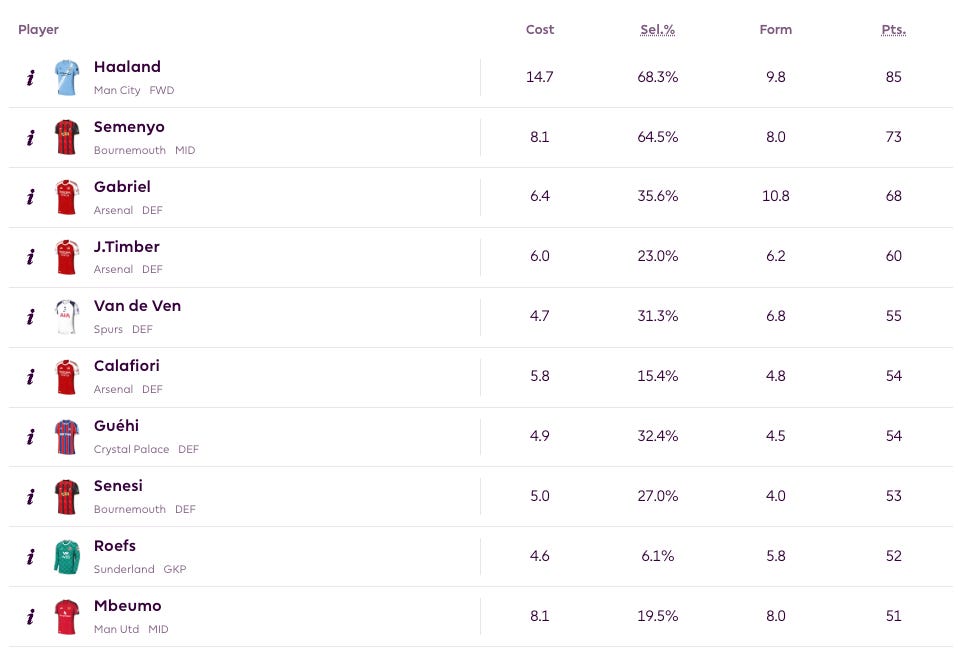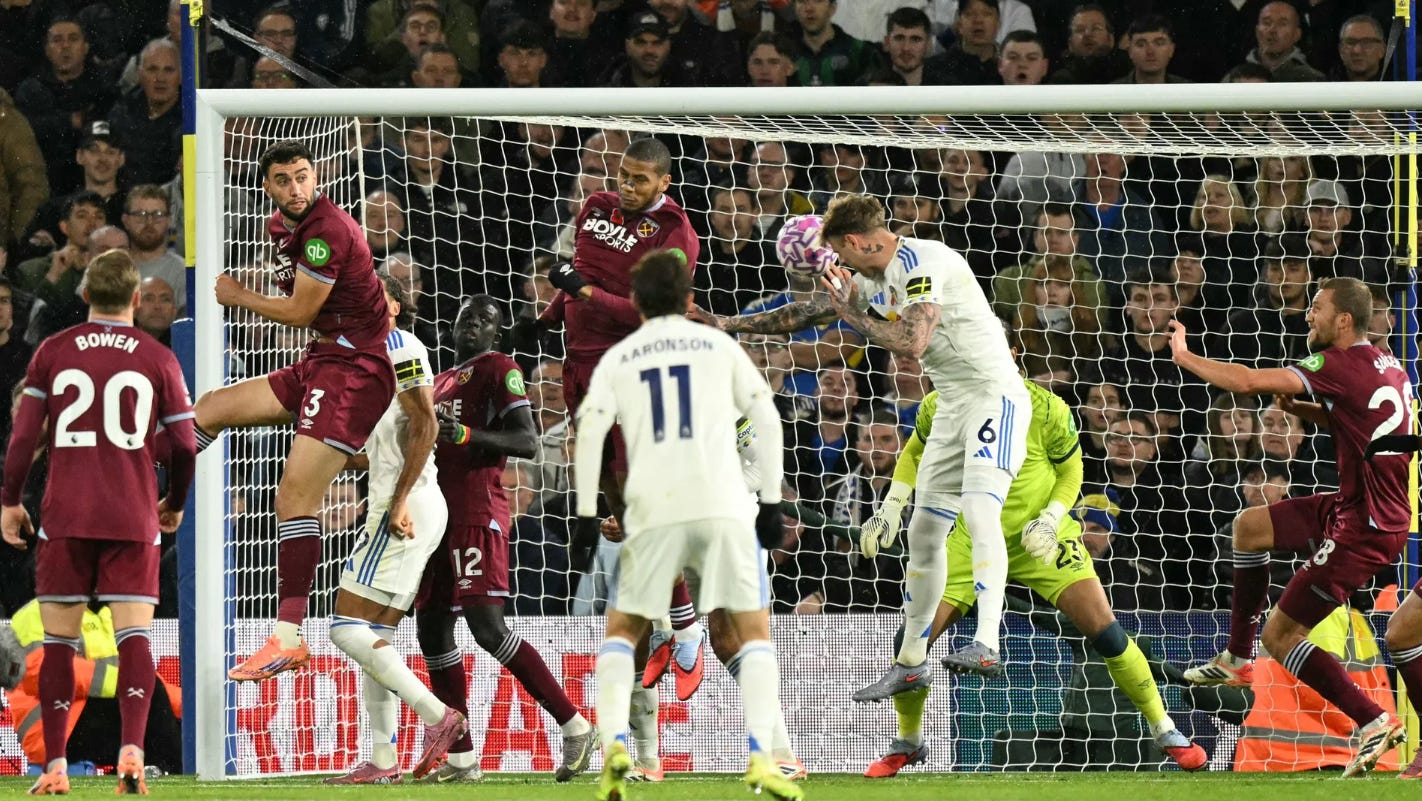Aerials. Scary set pieces. DEFCONs. The big reveal behind FPL’s defensive boom (and how to adapt)
The unexpected explained
Note: This newsletter is truncated in an email. You can click on “View entire message” to see the full post in your email app.
In any other season, defenders wouldn’t be among the most interesting topics to discuss.
However, the first nine weeks of the new Premier League campaign have turned the established order upside down. Here’s the top 10 of the highest scoring players so far this season:
Yes, 70% of these are defenders and goalkeepers.
If we extend it to the top 20, we’re getting:
2x FWD
3x GK
5x MID (two of those are defensive midfielders)
10x DEF
This means only 25% of the players are attacking-minded. It’s a combination of various factors, further affected by the still limited sample size of minutes.
The most obvious change year on year is the introduction of defensive contributions. However, that is not the sole reason.
To name a few others:
1️⃣ There’s an endless stream of defender hauls.
You saw it in Gameweek 9 with Joe Rodon (13 points), and especially Micky Van de Ven, who earned a massive 23-point haul:
2 goals
a clean sheet
full bonus
meeting a DEFCON threshold
2️⃣ There’s a high number of aerial duels that Premier League sides are currently contesting, which leads to a higher number of clearances… and more defcons.
3️⃣ There are more set-piece goals, long balls, and long throw-ins.
4️⃣ Midfielders and forwards are struggling, with only a few putting in top performances. This is probably a highly situational factor that may be affected by how the fixtures have unfolded.
You could argue that there are others, such as changes to the bonus point system, that are nerfing forwards.
The truth is, it’s still quite difficult to distinguish between noise and the clear signal without doing a deeper dive into the data. However, we can still describe what happened on the pitch and then see whether those events are sustainable in the long term.
And that’s what we’ll do today.
Aerial duels and clearances.
Set-piece goals.
Why are certain players getting their DEFCON points?
Will they continue to rack up those?
Why do Virgil van Dijk and Gabriel have many more of them this season?
By the time you read this in-depth piece, you will have all the answers.
Don’t forget the basics
I’ve already written several articles and Twitter/𝕏 threads about defensive contributions and defenders during the pre-season, and the main points I emphasised back then still stand today.
While defcons became an important part of the game, it’s always a combination of three pillars: clean sheets, attacking threat, and defensive contributions.
Also, the quality of a specific match-up is very important. Joe Rodon in GW9 was a perfect example — a player with the most attempts from corners in the entire league, facing a team that concedes the most dangerous chances from set-pieces (it’s already 5.5 expected goals and 9 actual goals). Add Leed’s defensive quality, the fact that they played West Ham, and his solid CBIT/90.
Remember the table above?
The highest-scoring defender, Gabriel, has earned a defcon 2-pointer in only 33% of his games. Jurriën Timber not once. Micky Van de Ven just once. Marc Guehi four times. Marcos Senesi is the only true DEFCON monster in the top 10 (7 times).
The number of defensive actions matters, but you should still adhere to basic principles most of the time.
Of course, there’s a group of players with higher defcon potential than others. And after those 9 Gameweeks, we can make an educated guess about who will continue to do so for the rest of the season. We will discuss these in a moment.
Firstly, I thought we could review one of the current trends. It might help you to make a better assessment.
The trend: aerial duels everywhere. How sustainable is it?
Many of us have already noticed that some defenders have started the season at a blistering pace when it comes to collecting DEFCON points, and if it continues like this, they’ll end up with far more than they had last season.
You earn those points by accumulating enough CBITs (duh), which are an acronym for clearances, blocks, interceptions, and tackles. The first one is important here.
Let’s look at the definition of OPTA’s clearance:
A clearance can be made with any part of the body, so headed clearances are included in that category.
I examined the data (pre-GW9) and found that the average Premier League team has contested 33% more aerial duels* than in GWs 1-8 last season.
From 24 to 32.
*Note: These are only the aerial duels, not the uncontested headers.
Various factors could explain this, and it does not necessarily imply that these numbers will remain the same throughout the season. The specific match-ups probably influenced this.
Also, eight gameweeks make up roughly 21% of the season — it’s still a small sample.
However, if I had to guess, I’d say that the difference is already too significant for the numbers to return to last season’s figures. The only real question now is how large the gap will become. And as we don’t speculate here on the Data Dribble, let’s look at some historical comparisons.
Interestingly, this season has a similar volume of aerial duels to the same period in the 20/21 and 21/22 seasons, respectively. So, what happened in the remaining 30 GWs back then?
The 20/21 season:
GWs 1-8: An average of 253 aerial duels per team (32 per gameweek)
GWs 9-38: 988 (33)
The whole season: 1,241 (33)
The 21/22 season:
GWs 1-8: 248 (31)
GWs 9-38: 920 (31)
The whole season: 1,167 (31)
Alright, this is interesting…
Let’s review another random season to increase the sample size and see if the aerial trend from GWs 1-8 can continue in the remaining weeks:
The 24/25 season:
GWs 1-8: 193 (24)
GWs 9-38: 794 (26)
The whole season: 987* (26)
*Last season was a Premier League outlier, as it was the first season to see fewer than 1,000 aerial duels (OPTA data via fbref.com) contested per team on average over the last seven seasons.
Okay, one more, just for sure:
The 23/24 season:
GWs 1-8: 201 (25)
GWs 9-38: 814 (27)
The whole season: 1,015 (27)
Based on a sample of four full seasons, we can see that early-season trends in aerial duels tend to persist.
It means that the 8/9-GW sample size appears sufficient for predicting the overall volume of aerial duels, although it might seem quite counterintuitive.
It seems the sample is enough to even out match-ups, and that tactical adjustments take time, so the trend remains pretty linear. Anyway, football is changing, and the teams won’t suddenly abandon this long-ball, long throw, second-ball, and long goal-kick style of play. Likely.
Also, we now have Sean Dyche in the league, and you know what that means:
So, if we consider that there’s a correlation between defenders receiving more defcons than in the previous season and the increased number of aerial duels (and clearances), it provides us with useful information.
We can now use this to do some player-level analysis.
All those Senesis, Andersens, Virgils, or Gabriels.
Take a deep breath now:
Keep reading with a 7-day free trial
Subscribe to Data Dribble to keep reading this post and get 7 days of free access to the full post archives.







